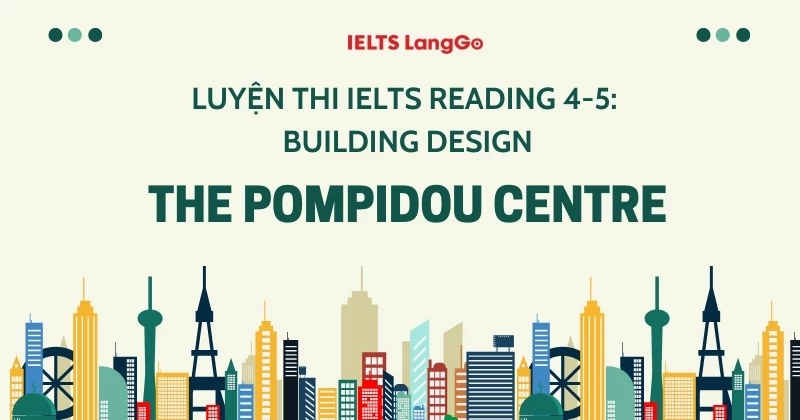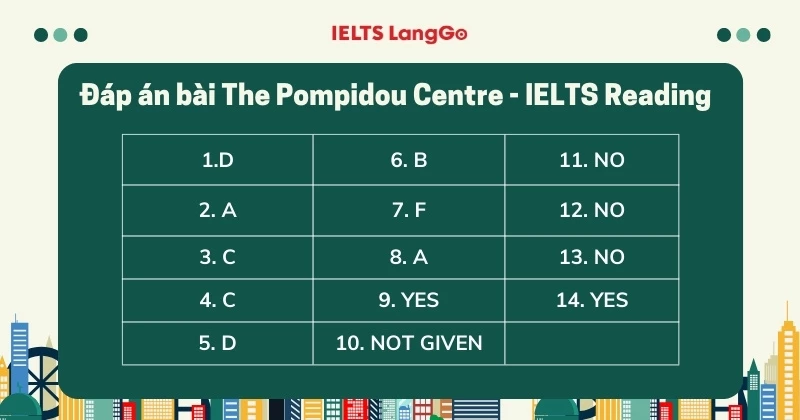



Trên thế giới có rất nhiều địa danh đẹp và kỳ thú, một trong số đó phải kể đến là Pompidou - một kiến trúc được xây dựng cách đây hơn 3 thập kỉ. Hãy tìm hiểu Pompidou thông qua bài đọc 'The Pompidou Centre' để biết thêm nhiều điều lý thú về nó cũng như luyện tập được những kỹ năng làm các dạng câu hỏi trong phần IELTS reading.
- Đọc và hiểu về nhận định có trong đề bài
- Gạch chân các từ khóa trong câu để xác định vị trí đoạn văn có trong bài đọc. ví dụ như các từ về tên riêng, các từ về chuyên môn...
- Dùng các từ khóa xác định nghĩa để so sánh với ý trong bài.
+ Các câu có từ mang nghĩa mạnh như always (luôn luôn), never (không bao giờ), only (chỉ một), … thường là đáp án “No”.
+ Các câu có từ can, may, might… thường là đáp án “Yes”.
+ Các tính từ, trạng từ miêu tả đi kèm luôn được chú ý dùng để so sánh với nghĩa của bài. Những câu có từ như vậy thường là “Not given”.
- Gạch chân các từ khóa để tìm đoạn văn có thông tin cần sử dụng cho câu hỏi.
- Không nên cố gắng sử dụng hết các ending vì số lượng ending luôn nhiều hơn số lượng của các vế đầu.
- Cần tập trung vào vế đầu và tìm đoạn văn liên quan có trong bài đọc rồi mới xem các lựa chọn của vế sau.
- Chỉ được sử dụng những thông tin có trong bài đọc để làm bài, không nên sử dụng kiến thức hay các suy nghĩ logic của mình để làm bài.
- Sau khi đã có câu trả lời phải kiểm tra lại xem có khớp với đoạn văn không.
- Gạch chân những từ khóa có trong câu hỏi của bài.
- Không nên đọc qua loa vì có thể một câu trả lời có vẻ đúng nhưng câu phía sau lại dùng một số từ như “but” hay “however”
- Đọc thật kĩ trước khi trả lời. phải đọc hết tất cả các câu trả lời, không nên chọn đáp án quá sớm.
- Khi bạn đã chọn được câu trả lời của mình hãy kiểm tra lại một cách nhanh chóng các tùy chọn khác xem có sai không.
- Sau khi đọc được 4 options thì đọc scan đọc kĩ lại Passage chứa đáp án của câu hỏi đó và bắt đầu vào loại trừ những đáp án sai từ vòng gửi xe. Thông thường trong câu Multiple choice sẽ có 2 đáp án trong 4 đáp án là rất nhảm nhí, có thể loại ngay từ vòng gửi xe, sau đó tập trung lựa chọn giữa 2 đáp án còn lại xem câu nào đúng.
Reading Passage:
| The Pompidou Centre More than three decades after it was built, the Pompidou Centre in Paris has survived its moment at the edge of architectural fashion and proved itself to be one of the most remarkable buildings of the 20th century. It was the most outstanding now building constructed in Paris for two generations. It looked like an explosion of brightly coloured service pipes in the calm of the city centre. However, when in 1977 the architects Richard Rogers and Renzo Piano stood among a large crowd of 5,000 at the opening of the Centre Culturel d'Art Georges Pompidou (known as the Pompidou), no one was really aware of the significance of this unusual building. Rogers was only 38 when he and Piano won the competition to design a new cultural centre for Paris in the old market site. Young, unknown architects, they had been chosen from a field of nearly 700 to design one of the most prestigious buildings of its day. After six difficult years, with 25,000 drawings, seven lawsuits, battles over budgets, and a desperate last-minute scramble to finish the building, it had finally been done. Yet the opening was a downbeat moment. The Pompidou Centre had been rubbished by the critics while it was being built, there was no more work in prospect for the architects, and their partnership had effectively broken down. But this was just a passing crisis. The Centre, which combined the national museum of modern art, exhibition space, a public library and a centre for modern music, proved an enormous success. It attracted six million visitors in its first year, and with its success, the critics swiftly changed their tune. The architects had been driven by the desire for ultimate flexibility, for a building that would not limit the movement of its users. All the different parts were approached through the same enormous entrance hall and served by the same escalator, which was free to anyone to ride, whether they wanted to visit an exhibition or just admire the view. With all the services at one end of the building, escalators and lifts at the other, and the floors hung on giant steel beams providing uninterrupted space the size of two football pitches, their dream had become a reality. The image of the Pompidou pervaded popular culture in the 1970s, making appearances everywhere - on record-album covers and a table lamp, and even acting as the set for a James Bond 1 film. This did much to overcome the secretive nature of the architectural culture of its time, as it enabled wider audience to appreciate the style and content of the building and so moved away from the strictly professional view. The following year, Rogers was commissioned to design a new headquarters for Lloyd's Bank in London and went on to create one of Britain's most dynamic architectural practices. Piano is now among the world's most respected architects. But what of their shared creation? It was certainly like no previous museum, with its plans for a flexible interior that not only had movable walls but floors that could also be adjusted up or down. This second feature did not in the end survive when the competition drawings were turned into a real building. In other ways, however, the finished building demonstrated a remarkable degree of refinement - of craftsmanship even - in the way the original diagram was transformed into a superbly detailed structure. It was this quality which, according to some critics, suggested that the Pompidou should be seen as closer to the 19th-century engineering tradition than the space age. Nevertheless, as a model for urban planning, it has proved immensely influential. The Guggenheim in Bilbao* and the many other major landmark projects that were built in the belief that innovatively designed cultural buildings can bring about urban renewal are all following the lead of the Pompidou Centre. Other buildings may now challenge it for the title of Europe s most outlandish work of architecture. However, more than a quarter of a century later, this construction - it is hard to call it a building when there is no façade, just a lattice of steel beams and pipes and a long external escalator snaking up the outside - still seems extreme. Today, the Pompidou Centre itself still looks much as it did when it opened. The shock value of its colour-coded plumbing and its structure has not faded with the years. But while traditionalists regarded it as an ugly attack on Paris when it was built, they now see it for what it is - an enormous achievement, technically and conceptually. |
Questions 1-4
Choose the correct letter, A, B, C or D.
1. What does the writer sav in the first paragraph about the opening of the Pompidou Centre?
A. The elderly did not like it.
B. The architects were not present.
C. The atmosphere was very noisy.
D. The people did not realise its importance.
2. What does the writer say in the second paragraph about the construction of the Pompidou?
A. There was a hurry to complete it.
B. It cost less than expected.
C. Other experts helped draw the plans.
D. The market location was criticised.
3. What is the writer’s main purpose in the third paragraph?
A. to explain the multi-functional role of the centre
B. to praise the architects for their design ideas
C. to say why some people’s opinions quickly altered
D. to show how the media benefited from its success
What was the architects’ ‘dream’, referred to in the fourth paragraph?
A. to become famous
B. to provide entertainment
C. to allow visitors to use it freely
D. to build the biggest museum in the world
Questions 5-8
Complete each sentence with the correct ending, A-F, below.
5. ………….. The escalators and lifts inside the Pompidou
6. ………….. In the 1970s, pictures of the Pompidou
7. ………….. The original plans for the floors of the Pompidou
8. ………….. The detailed structure of the finished building
A reminded some people of past building styles.
B were used to decorate everyday objects.
C fitted in well with the external surroundings.
D were situated on one side of the building.
E showed people which area to visit.
F were changed during the construction process.
Questions 9-14
Complete each sentence with the correct ending, A-F, below.
Do the following statements agree with the views of the writer in the reading passage?
Write
YES if the statement agrees with the views of the writer
NO if the statement contradicts the views of the writer
NOT GIVEN if it is impossible to say what the writer thinks about this
9. ……………. The Pompidou has influenced the way cities are designed.
10. ………….. The Guggenheim has been more popular than the Pompidou.
11. ………….. The word building fits the Pompidou better than the word construction.
12. ………….. The Pompidou’s appearance has changed considerably since it opened.
13. ………….. Nowadays, the design of the Pompidou fails to shock people.
14. ………….. The traditionalist view of the Pompidou has changed over the years.

ĐÁP ÁN CHI TIẾT:
1. D. The people did not realise its importance.
Dẫn chứng: “no one was really aware of the significance of this unusual building.” (không ai thực sự nhận thức được tầm quan trọng của tòa nhà bất thường này.)
Giải thích: Câu này cho thấy vào thời điểm khai trương, mọi người chưa hiểu rõ ý nghĩa thực sự của Pompidou Centre, điều này khớp với phương án D.
2. A. There was a hurry to complete it.
Dẫn chứng: “…a desperate last-minute scramble to finish the building…” (một cuộc chạy đua tuyệt vọng vào phút chót để hoàn thành tòa nhà…)
Giải thích: Cụm từ "desperate last-minute scramble" cho thấy việc hoàn thành tòa nhà diễn ra vội vã vào phút cuối. Điều này phù hợp với phương án A.
3. C. to say why some people’s opinions quickly altered.
Dẫn chứng: “…the critics swiftly changed their tune.” (các nhà phê bình nhanh chóng thay đổi quan điểm của họ.)
Giải thích: Câu này cho thấy ban đầu các nhà phê bình chỉ trích Pompidou Centre, nhưng sau đó họ thay đổi ý kiến do sự thành công của tòa nhà. Điều này khớp với phương án C.
4. C. to allow visitors to use it freely.
Dẫn chứng: “…for a building that would not limit the movement of its users.” (một tòa nhà sẽ không hạn chế sự di chuyển của người dùng.)
Giải thích: Cụm từ "not limit the movement of its users" cho thấy mục tiêu của kiến trúc sư là tạo ra không gian linh hoạt, nơi mọi người có thể đi lại thoải mái, khớp với phương án C.
5. D. were situated on one side of the building.
Dẫn chứng: “…escalators and lifts at the other…” (các thang cuốn và thang máy ở phía bên kia…)
Giải thích: Điều này có nghĩa là toàn bộ hệ thống thang máy và thang cuốn đều nằm ở một phía của tòa nhà, phù hợp với phương án D.
6. B. were used to decorate everyday objects.
Dẫn chứng: “making appearances everywhere - on record-album covers and a table lamp…” (xuất hiện ở khắp mọi nơi - trên bìa album nhạc và cả trên đèn bàn…)
Giải thích: Hình ảnh của Pompidou được sử dụng rộng rãi trên các vật dụng hàng ngày, điều này khớp với phương án B.
7. F. were changed during the construction process.
Dẫn chứng: “floors that could also be adjusted up or down. This second feature did not in the end survive…” (các sàn có thể điều chỉnh lên hoặc xuống. Nhưng tính năng thứ hai này cuối cùng đã không được giữ lại…)
Giải thích: Tính năng ban đầu là sàn có thể di chuyển đã bị loại bỏ trong quá trình xây dựng. Điều này phù hợp với phương án F.
8. A. reminded some people of past building styles.
Dẫn chứng: “…suggested that the Pompidou should be seen as closer to the 19th-century engineering tradition…” (gợi ý rằng Pompidou nên được xem là gần hơn với truyền thống kỹ thuật thế kỷ 19…)
Giải thích: Một số nhà phê bình cho rằng thiết kế của Pompidou có những nét giống với công trình kỹ thuật thế kỷ 19, điều này khớp với phương án A.
9. YES
Dẫn chứng: “it has proved immensely influential. The Guggenheim in Bilbao… are all following the lead of the Pompidou Centre.” (nó đã chứng tỏ sức ảnh hưởng to lớn. Guggenheim ở Bilbao… đều đi theo mô hình của Pompidou Centre.)
Giải thích: Câu này khẳng định Pompidou đã có ảnh hưởng lớn đến thiết kế đô thị. Điều này phù hợp với câu hỏi.
10. NOT GIVEN
Dẫn chứng: Không có thông tin nào trong bài so sánh mức độ phổ biến giữa Guggenheim và Pompidou.
Giải thích: Bài chỉ nói Guggenheim được xây dựng theo mô hình của Pompidou, nhưng không nói rõ nó có phổ biến hơn hay không.
11. NO
Dẫn chứng: “it is hard to call it a building when there is no façade…” (thật khó để gọi nó là một tòa nhà khi không có mặt tiền…)
Giải thích: Câu này cho thấy tác giả cho rằng "construction" (công trình) phù hợp hơn so với "building" (tòa nhà), vì thế đáp án là NO.
12. NO
Dẫn chứng: “Today, the Pompidou Centre itself still looks much as it did when it opened.” (Ngày nay, Pompidou Centre vẫn trông giống như khi nó mới khai trương.)
Giải thích: Điều này cho thấy diện mạo của Pompidou không thay đổi đáng kể, nên đáp án là NO.
13. NO
Dẫn chứng: “The shock value of its colour-coded plumbing and its structure has not faded with the years.” (Giá trị gây sốc của hệ thống ống nước được mã màu và cấu trúc của nó vẫn chưa phai nhạt theo năm tháng.)
Giải thích: Nếu giá trị gây sốc vẫn còn, điều đó có nghĩa là nó vẫn gây ấn tượng mạnh. Vì vậy, đáp án là NO.
14. YES
Dẫn chứng: “But while traditionalists regarded it as an ugly attack on Paris when it was built, they now see it for what it is - an enormous achievement.” (Nhưng trong khi những người theo chủ nghĩa truyền thống từng coi nó là một cuộc tấn công xấu xí vào Paris khi nó mới được xây dựng, thì giờ đây họ đã nhìn nhận nó đúng với giá trị của nó - một thành tựu vĩ đại.)
Giải thích: Câu này cho thấy quan điểm của những người theo chủ nghĩa truyền thống đã thay đổi theo thời gian, phù hợp với đáp án YES.
Trên đây là bài luyện thi IELTS Reading chủ để Building Design thông qua bài Reading: The Pompidou Centre kèm có đáp án và giải thích chi tiết. Hy vọng bài viết này sẽ giúp bạn ôn luyện hiệu quả và đạt điểm cao trong kỳ thi. Đừng quên theo dõi IELTS LangGo để học thêm về các kiến thức tiếng Anh và IELTS bạn nhé!



ĐẶT LỊCH TƯ VẤN MIỄN PHÍ LỘ TRÌNH Săn ƯU ĐÃI lên tới 12.000.000đ